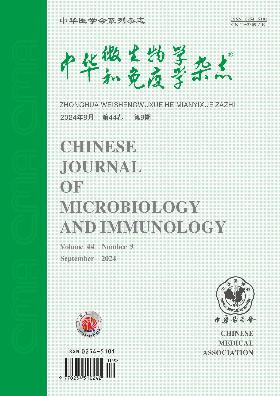Establishment and evaluation of receptor binding domain (RBD)-based ELISA for Middle East respiratory syndrome coronavirus (MERS-CoV) antibody detection
Q4 Immunology and Microbiology
引用次数: 0
Abstract
Objective To establish an indirect enzyme-linked immunosorbent assay (ELISA)and to compare the efficiency of receptor binding domain (RBD) proteins in different forms for Middle East respiratory syndrome coronavirus (MERS-CoV) antibody detection. Methods The monomeric and trimeric forms of MERS-CoV RBD were expressed in Bac-insect cells, 293T cells and ExpiCHO-S™ expression system and then purified. The purified RBD proteins were identified with native gel electrophoresis and Western blot. Then, an equal amount of each RBD protein was used as coating antigen to establish an ELISA for detecting MERS-CoV IgG titer. For comparison, the newly developed ELISA and the commercial MERS-CoV IgG antibody detection kit (Euroimmune with S1 as the coating antigen) were used to measure the MERS-CoV antibody reference panel supplied by World Health Organization (WHO). Results The purified monomeric and trimeric MERS-CoV RBD were successfully prepared using 293T cells and ExpiCHO-S™ system. RBD antigens of different forms and from different systems could recognize MERS-CoV specific antibody without having any cross reaction with the sera from healthy adults. The in-house RBD-based ELISA had good detection consistency with the Euroimmune commercial kit. The positive samples showed higher and more concentrated values based on the RBD trimer than the monomer. Conclusions Novel indirect ELISA methods based on the monomeric and trimeric forms of RBD protein were established. The trimetric form-based ELISA achieved higher detection efficiency than the one using the monomer antigen, suggesting that it could be uses as a competent alternative to the commercial kit. Key words: Middle East respiratory syndrome coronavirus (MERS-CoV); Receptor binding domain (RBD); Antibody; Enzyme-linked immunosorbent assay (ELISA)基于受体结合域(RBD)的中东呼吸综合征冠状病毒(MERS-CoV)抗体ELISA检测方法的建立与评价
目的建立间接酶联免疫吸附法(ELISA),比较不同形式受体结合域(RBD)蛋白检测中东呼吸综合征冠状病毒(MERS-CoV)抗体的效率。方法分别在bac -昆虫细胞、293T细胞和ExpiCHO-S™表达系统中表达MERS-CoV RBD的单体和三聚体,并进行纯化。用天然凝胶电泳和Western blot对纯化的RBD蛋白进行鉴定。然后将各RBD蛋白等量作为包被抗原,建立检测MERS-CoV IgG滴度的ELISA试剂盒。采用新开发的ELISA和市售的MERS-CoV IgG抗体检测试剂盒(以S1为包被抗原的Euroimmune)对世界卫生组织(WHO)提供的MERS-CoV抗体参考板进行检测比较。结果利用293T细胞和ExpiCHO-S™系统成功制备了纯化的MERS-CoV单体和三聚体RBD。不同形式、不同系统的RBD抗原均能识别MERS-CoV特异性抗体,且与健康成人血清无交叉反应。内部基于rbd的ELISA与Euroimmune商用试剂盒检测一致性良好。RBD三聚体的阳性样品比单体的阳性样品值更高、更集中。结论建立了基于RBD蛋白单体和三聚体的间接ELISA检测方法。基于三计量形式的ELISA检测效率高于使用单个抗原的ELISA,这表明它可以作为商业试剂盒的有力替代品。关键词:中东呼吸综合征冠状病毒;受体结合域(RBD);抗体;酶联免疫吸附试验(ELISA)
本文章由计算机程序翻译,如有差异,请以英文原文为准。
求助全文
约1分钟内获得全文
求助全文
来源期刊

中华微生物学和免疫学杂志
Immunology and Microbiology-Virology
CiteScore
0.50
自引率
0.00%
发文量
6906
期刊介绍:
Chinese Journal of Microbiology and Immunology established in 1981. It is one of the series of journal sponsored by Chinese Medical Association. The aim of this journal is to spread and exchange the scientific achievements and practical experience in order to promote the development of medical microbiology and immunology. Its main contents comprise academic thesis, brief reports, reviews, summaries, news of meetings, book reviews and trends of home and abroad in this field. The distinguishing feature of the journal is to give the priority to the reports on the research of basic theory, and take account of the reports on clinical and practical skills.
 求助内容:
求助内容: 应助结果提醒方式:
应助结果提醒方式:


